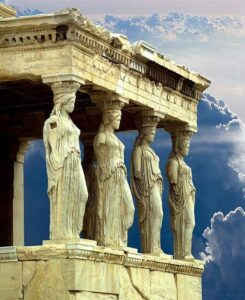Introduction
In the grand heritage of ancient Greek architecture, one distinct and captivating feature stands out—the Caryatid. These statuesque female figures serve not only as structural supports but also as representations of grace, beauty, and power. As stone columns carved in the shape of elegant women, Caryatids are symbols of the intersection between functionality and artistry. This article explores the origins, symbolism, and influence of Caryatids in architecture, with a close look at their most famous example—the Erechtheion Temple in Athens.
1. Historical Context of Caryatids
The term Caryatid originates from the Greek word “Karyatides,” meaning “maidens of Karyai.” Karyai was an ancient town in the region of Laconia, where women would perform ceremonial dances in honor of the goddess Artemis. In architectural use, Caryatids embody this cultural reverence for the divine feminine. Their form and presence in temples reveal the Greeks’ inclination towards integrating mythology and reverence into the very structures they inhabited.
Origins and Purpose
The Caryatid as a column form is not merely decorative; it symbolizes an evolution in architectural support that merges the divine feminine with structural necessity. Rather than mere stone or marble columns, these figures bring life and movement, as if the temple were supported by living beings, symbolizing strength in beauty. Caryatids were used in some of the most significant temples of the time, showcasing the Greeks’ appreciation for symmetry, symbolism, and aesthetics.

2. Symbolism and Iconography of Caryatids
Each Caryatid is a marvel of craftsmanship, meticulously carved to reflect elements of femininity, strength, and timeless beauty. Their poses and attire often reflect the roles they play within the structure and the cultural ideals they represent.
Representing Grace and Strength
The statues generally appear draped in the traditional Greek peplos or chiton, garments that fall in smooth, elegant folds. This drapery was likely designed to evoke the aesthetic of flowing movement, similar to the way actual fabric would ripple, softening the rigidity of stone. By contrast, their steadfast, erect postures project strength, stability, and unwavering duty, reminding viewers of the virtues and resilience attributed to the feminine in Greek society.
Iconography and Symbolic Interpretation
The Caryatid’s gaze and stance often embody serenity and modesty. Yet, their sheer presence—bearing the weight of roofs and entablatures—shows the Greeks’ respect for the resilience and power of women, seen as central figures in both myth and reality. The Caryatids on the Erechtheion, for example, represent the mythological daughters of Erechtheus, the Athenian king, who serve as guardians of the sacred space.

3. The Erechtheion Temple: A Pinnacle of Caryatid Architecture
The Erechtheion temple, built on the Acropolis in Athens during the late 5th century BCE, stands as the most celebrated example of Caryatid columns. Erected in honor of Athena and Poseidon, this temple housed a series of six Caryatids that support the southern porch, lending a dignified and ethereal character to the structure.
Unique Structural Innovation
The Erechtheion’s Caryatids exemplify an architectural breakthrough. Rather than traditional fluted columns, the temple’s designers employed the Caryatids to emphasize a harmonious blend of architecture and sculpture. This transformation illustrates the Greeks’ advanced approach to construction and artistic design, pushing beyond practicality into realms of metaphor and mythological symbolism.
Cultural and Religious Significance
For the ancient Athenians, the Caryatids were not mere ornamental figures but rather sacred embodiments. Their placement in the Erechtheion—a temple that, according to myth, marked the site of Athena’s contest with Poseidon—further solidifies their role as divine witnesses, forever standing guard over the city’s most hallowed ground. Each Caryatid faces forward, as if eternally vigilant, symbolizing the protection and stability Athena provides to her people.

4. The Lasting Influence of Caryatid Architecture
The Caryatid form, though unique to ancient Greece, has influenced architectural styles across centuries and cultures. Echoes of Caryatids can be seen in various Renaissance and Neoclassical buildings, where they often appear as decorative pillars and embellishments in facades.
Neoclassical Revival and Global Influence
The Renaissance revived interest in classical forms, including Caryatids, inspiring architects worldwide to incorporate these figures into their designs. Neoclassical structures in Europe, particularly in France and Britain, employed variations of Caryatids, symbolizing an appreciation for the artistry and symbolism associated with ancient Greece.
Modern Architecture and Artistic Homage
Today, Caryatids continue to inspire both traditional and modern interpretations in art and architecture. Artists and architects reinterpret them as symbols of female strength and endurance, transforming them to fit contemporary styles while maintaining their classical roots. In a way, the Caryatids have become timeless emblems, embodying humanity’s enduring respect for beauty and resilience.
